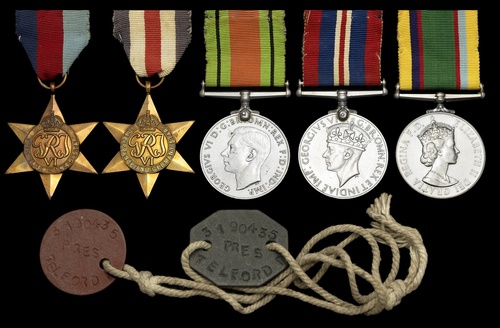
Auction: 25001 - Orders, Decorations and Medals
Lot: 92
An 'Arnhem P.O.W.' group of five awarded to Corporal R. S. Telford, 7th Battalion, King's Own Scottish Borderers, who went 'in the bag' on 23 September during a fierce tank attack on the Battalion's perimeter
1939-45 Star; France and Germany Star; Defence and War Medals 1939-45; Cadet Forces, E.II.R. (WO. R. S. Telford. A.T.C.), sold together with the recipient's dog tags and soldier's release book, light pitting and contact marks, very fine (5)
Robert Smith Telford was born on 13 June 1919, a native of Dumfriesshire and enlisted on 1 September 1939 with the King's Own Scottish Borderers. Joining the 7th (Galloway) Battalion he was with them in Scotland during the Fall of France, indeed the Battalion was not to leave Britain for some time. They transferred to the 1st Air Landing Brigade in 1943 and continued to train with them until the D-Day Landings.
7th Battalion took off on 17 September 1944 for Operation Market Garden, landing in the Ede area in 1944 and initially all went well. The next day however they came under attack by several parties of German troops with armoured vehicles in support, a situation which would become increasingly familiar over the next week of fighting.
Moving off they fought a sharp action at Johanna Hoeve farm but managed to repel a German attack and continue on towards Arnhem. Arriving at Oosterbeek, some 5 kilometeres west of Arnhem on 19 September they dug in there to assume their corner of the perimeter. The enemy started to probe their lines not long later, and by 09:00 on 20 September they had established the Battalion's positions allowing the battle to begin in earnest. Some of the ferocity of the fighting can be ascertained from the war diary which notes the first armoured 'kill' made by the unit:
'The first "kill" was an armoured car which was blown up and set on fire by the atk gun covering the NORTH face. Later another atk gun under Lt HANNAH, and escorted by a Pl of B Coy, went out to watch the rd leading SOUTH from the rd and rly crossing at 699791. Soon after it was in posn a TIGER tk, towing a flame-throwing apparatus, appeared and a spirited action took place. As a result of the courageous behaviour of our atk gun crew, and of Cpl WATSON and Pte McWHIRTER in particular, the TIGER tk was completely knocked out and the crew killed.'
Through that day and the next, 7th Battalion halted the enemy advance, unable to withdraw due to constant pressure and concern over losing their limited equipment in the dark. A break in the attacks on 22 September allowed them the chance to reform and prepare their positions for another attack, however they could not have been prepared for the forces ranged against them.
A heavy barrage opened the day and at around 11:00 'B' Company came under heavy attack by a force of tanks with infantry and artillery support. Their anti-tank gun was knocked out, forcing them back from a line of buildings, however they gamely held on to their slit trenches and bunkers, fighting for every yard. Their partial withdrawal allowed the German infantry to push onto the flank of 'C' company who also came under attack from Armoured cars to their front.
Soon the action became an attempt by the Germans to consolidate a piece of their hard won gains in the face of heavy fire and counter-attacks by the Battalion. They were able to prepare machine gun positions in the wood between 'B' and 'C' companies, thus keeping that gap open and completing their objective.
The only option was a counter-attack which was carried out by 'C' Company, who despite several losses managed to retake the wood and capture a number of the enemy. The line re-established they managed to hold off further attacks for the rest of the day, taking a tally of German tanks, damaged or destroyed in the process. It was noted in the war diary that the Regimental Aid Post was full to bursting as the Medical Aid Post had fallen into enemy hands, suggesting that some areas of the perimeter were still occupied by the enemy.
Telford is listed as being taken prisoner of war during the days fighting, it is likely he was a victim of the morning offensive which almost saw the line break. Taken to Stalag 11B at Fallingbostel he remained there until being repatriated at the end of the war. Upon his return to the British Army he was posted to a Holding Regiment, Royal Artillery but saw no service with them instead being demobilised on 11 April 1946. Later joining the Cadet Forces he was awarded the Cadet Forces medal with them. Telford died in Dumfries on 8 December 1898 and is buried at Lockerbie; sold together with copied research, a set of original dog tags and an original soldier's release book named to the recipient.
Subject to 20% VAT on Buyer’s Premium. For more information please view Terms and Conditions for Buyers.
Estimate
£1,000 to £1,400
Starting price
£800




